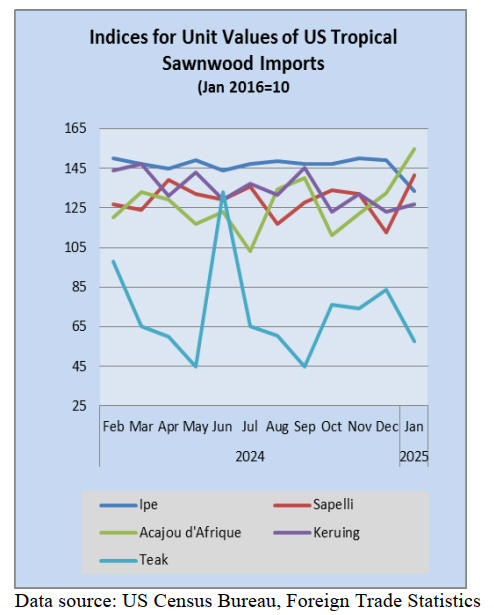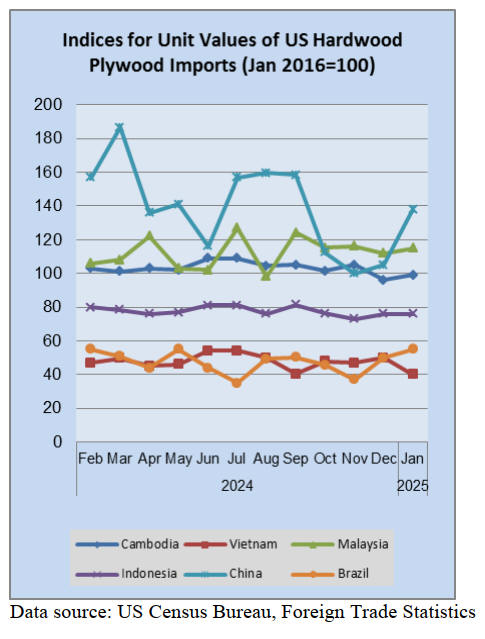|
Report from
North America
US housing starts jump despite home builders’
mounting worries
Construction of new homes rose 11% in February as
builders coming off a harsh winter ramped up new
projects. But most economists expect home builders to
pull back in the coming months, which could worsen the
housing-affordability crisis in the United States.
In February, housing starts rose to a 1.5 million annual
pace from 1.35 million the previous month the government
reported. February’s new-home construction was down
3% from a year ago.
Builders accelerated the construction of new homes
following a tough winter when many had to halt work. The
data indicated that housing starts rose strongly in the
Northeast and in the South as builders restarted work after
January’s severe weather eased.
But “with tariff concerns continuing to weigh on
homebuilders’ confidence, a slowdown in construction
looks likely in the second half of this year,” Harry
Chambers, an assistant economist at Capital Economics,
wrote in a note. Building permits, a sign of future
construction, fell 1.2% from the previous month to a 1.46
million rate in February.
“Our premise that the jump in housing starts in February
was more payback from weather-related disruptions in
January than builders gearing up for the spring sales
season would seem to be supported by the permits data,”
Richard Moody, chief economist at Regions Financial
Corporation, wrote in a note.
The pace of construction was uneven across regions. New-
home construction surged in the Northeast by 47%,
followed by the South at 18% and by the West at 6%. But
starts in the Midwest fell by nearly 25%.
In a recent survey of builders, they were increasingly
pessimistic about the housing market and expressed
concerns about rising costs due to tariffs on imported
goods imposed by the Trump administration. Buddy
Hughes, chair of the National Association of Home
Builders, said that builders were still worried about buyers
being unable to afford homes and about the impact of
“elevated financing and construction costs as well as
tariffs on key building materials.”
In Canada, the national housing agency reported that the
annual pace of housing starts in February slowed 4%
compared with January. The Canada Mortgage and
Housing Corporation says the seasonally adjusted annual
rate housing starts came in at 229,030 units for February,
down from 239,322 in January.
See: https://www.census.gov/construction/nrc/current/index.html
US home sales rose more than expected in February
The National Association of Realtors reported that
February US existing home sales were up 4%, much
higher than expected. Analysts predicted a 3% drop. Total
home sales for the month were 4.26 million, 1.2% lower
than February 2024, when 4.31 million homes sold.
At the end of February, 1.24 million homes were in the
registered housing inventory, up 5% over January. The
number of homes available increased 17% from a year
ago.
In February, existing-home sales in the Northeast
decreased 2% from January to an annual rate of 500,000,
up 4% from February 2024. In the Midwest, sales were
unchanged in February at an annual rate of 1 million, up
1% from the prior year.
Existing-home sales in the South climbed 4% from
January to an annual rate of 1.91 million in February,
down 4.0% from one year before.
In the West, existing-home sales jumped 13% in February
to an annual rate of 850,000, identical to a year ago.
See: https://www.nar.realtor/research-and-statistics/housing-
statistics/existing-home-sales
US jobs report steady, but impact of federal cutbacks
and tariffs looms
US employers added 151,000 jobs in February, the first
full month under the new US administration, the Labour
Department reported. The gain extended a streak of job
growth to 50 months. The unemployment rate ticked up
slightly, to 4.1%, from 4% in January.
The report showed a decline of 10,000 in federal
employment. But it was based on surveys conducted in the
second week of February, as the administration’s mass
firings, buyouts and hiring freezes at federal agencies were
still unfolding.
The survey has likely not registered “more than a sliver of
the full impact from federal government layoffs,” said
Preston Caldwell, chief US economist at Morningstar.
“That should change in next month’s job report.”
A similar waiting game is in store for those hoping to
ascertain the effects that President Trump’s tariffs — those
imposed and those still threatened — may have on global
trading partners, business investment and employment.
Even without the shake-up in foreign trade and federal
employment, private-sector hiring has slowed substantially
from the blowout pace of 2021 to 2023. That has left
labour market analysts and financial commentators
gearing up for a potential cooling in economic growth this
year. For now, though, unemployment continues to glide
just above record lows. And gains in average hourly
earnings for workers have kept up a solid pace, overtaking
inflation since mid-2023.
Employment showed little change over the month in major
industries including construction and manufacturing.
See:
https://www.nytimes.com/2025/03/07/business/economy/jobs-
report-february.html
and
https://www.bls.gov/news.release/empsit.nr0.htm
Consumer confidence continues to slide
Consumer sentiment slid another 11% this month, with the
University of Michigan’s latest survey showing consistent
declines across all groups by age, education, income,
wealth, political affiliations and geographic regions.
Sentiment has now fallen for three consecutive months
and is currently down 22% from December 2024.
While the Michigan’s survey often shows sharp partisan
differences in sentiment, the March survey found a 10%
decline in future expectations among Republicans. The
sentiment among Democrats was off by 24%, while
among independents it was down 12%.
“While current economic conditions were little changed,
expectations for the future deteriorated across multiple
facets of the economy, including personal finances, labor
markets, inflation, business conditions, and stock
markets,” survey director Joanne Hsu said in an analysis.
“Many consumers cited the high level of uncertainty
around policy and other economic factors; frequent
gyrations in economic policies make it very difficult for
consumers to plan for the future, regardless of one’s policy
preferences.”
See: http://www.sca.isr.umich.edu/
US manufacturing grew in February
Economic activity in the manufacturing sector expanded
for the second month in a row in February after 26
consecutive months of contraction, say the nation's supply
executives in the latest Manufacturing ISM Report On
Business.
ISM’s manufacturing PMI slipped to 50.3 last month from
50.9 in January which marked the first expansion since
October 2022 and likely reflected factories front-loading
imports to beat tariffs. A PMI reading above 50 indicates
growth in the manufacturing sector, which accounts for
10.3% of the US economy.
Worries about duties on imports dominated commentary
ISM survey, with respondents saying the tariffs being
pushed against trading partners such as Canada, Mexico
and China had created an uncertain operating
environment.
Coming on the heels of weak consumer spending a surge
in the goods trade deficit and a decline in homebuilding in
January, the survey reinforced views that the economy lost
significant momentum early in the first quarter. Some
economists are expecting a gross domestic product
contraction this quarter.
Ten industries including miscellaneous manufacturing,
primary metals, wood products and transportation
equipment reported growth last month. Among the five
industries reporting contraction for the month were
furniture and related products, machinery as well as
computer and electronic products.
See: https://www.ismworld.org/supply-management-news-and-
reports/reports/ism-report-on-business/
and
https://www.msn.com/en-us/money/markets/us-manufacturing-
stable-price-pressures-surge-ahead-of-tariffs-storm/ar-
AA1Aae9b?ocid=BingNewsVerp
Timber import investigation
The US Department of Commerce is seeking public
comments for its investigation into whether imports of
lumber, timber and their derivative products constitute a
threat to national security.
On March 1, the US President signed an executive order
directing the Secretary of Commerce Howard Lutnik to
investigate whether imports of timber and lumber and their
derivative products threaten national security; recommend
actions to mitigate such threats, including potential tariffs,
export controls or incentives to increase domestic
production and recommend policies to strengthen US
timber and lumber production through strategic
investments and “permit reforms.”
The Commerce Department has until November 26 to
conclude the investigation though it is expected to be
completed before then.
The order follows a similar probe into the copper industry,
as well as widespread 25% tariffs on steel and aluminum
which also were implemented out of concern over national
security.
See: https://www.furnituretoday.com/industry-issue/trump-
administration-seeks-comments-for-its-lumber-timber-import-
investigation/
Study shows increased demand for decks and other
outdoor living spaces
Outdoor living has always held appeal, picture homes in
warm-weather states with lanais and outdoor kitchens plus
homes with expansive decks and patios. However, the
pandemic amplified the importance of these spaces.
According to industry research, this new appreciation for
outdoor spaces has persisted, driving a significant increase
in demand for design and renovation services.
Several recent studies underscore the growing demand for
enhanced outdoor spaces. For example, the International
Casual Furnishings Association’s (ICFA) 2024 Outdoor
Trend Report reveals that 82% of homeowners feel they
are underutilising their outdoor areas, with 94%
expressing a desire to spend more time outdoors if their
spaces were upgraded. This translates into concrete action,
with 67% of households planning to purchase new outdoor
furnishings.
One of the most significant trends shaping outdoor living
is the rise of a four-season room. These enclosed spaces,
often converted from existing decks, feature amenities
such as fireplaces, large windows, and even heating and
cooling system, allowing homeowners to enjoy the
outdoors year-round, regardless of weather.
See: https://www.woodworkingnetwork.com/closets/outdoor-
living-takes-shape


|